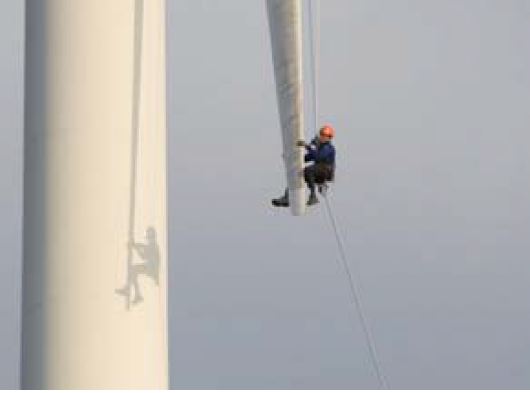I have discussed in another post the different type of damages that a wind turbine blade can suffer and the various detection systems.
There is an extensive list of potential problems: cracks, delamination, debonding, erosion of the leading edge (the first area of the blade to “see the wind”) are some of the issues observed.
This variety of potential failures is partially explicable with the complexity of the blade and the materials used in its fabrication: usually blades are made with an external aerodynamic shell of a composite material, stiffened by a box beam.
A composite is a material fabricated mixing two or more components – in the case of the blade a “matrix” usually made with an epoxy or polyester resin with embedded “fibres” (frequently glass fibres or carbon fibres).
Internally, shear webs, a box beam or a similar solution is used to give stiffness to the blade.
Additionally other materials can be used – some kind of gel for the coating of the external surface, metallic conductors to protect the blade in case a lightning strike the tip (an event that is more frequent then what you might suppose), adhesive material for the joints and very light material for the core (for instance balsa or synthetic foams).
On top of the intrinsic complexity of the blade there are other factors that contribute to the variety of damages observed: during its life the blade is exposed to a wide range of situations that can originate a damage – from the factory (fabrication mistakes) to transport by ship, train or truck to manipulation before the erection to a very long (20+ years) operational life.
During the operational life harsh weather is a major to blade damages (e.g. rain, ice, lightning). Additionally moisture can contribute worsening the situation entering the cracks and acceleration the degradation of the materials.
Impact is another source of damages. There are quite a lot of study on wind turbines and bird impact – however other type of impacts are possible as well, for instance during transportation or storage (sometime blades are stored for months before erection).
Not all problems are easily detectable with a naked eye: for this reason a variety of tools has been developed to identify internal damages.
Among the solutions most frequently used:
- Ultrasonic waves: they travel through composite materials and internal damages acts as discontinuities with a change in acoustic impedance that can be measured
- Digital shearography: this is an interferometric technique that uses coherent laser illumination to measure surface deformation
- Passive and active thermography: as in the case of ultrasounds internal damages create a change in the distribution of temperatures. “Passive” means that the environmental temperature of the blade is used while “active” means that the tool itself heat the blade.
What happen when an issue is detected?
Unfortunately there are not so many competent technicians able to repair a blade – and many of them work for the wind turbine manufacturers and keep travelling from wind farm to wind farm. There is often some kind of warranty involved, at least for the first years of the project.

Obviously the best solution would be to dismantle the blade and work on the ground.
Unfortunately sometime this is not possible – maybe because a crane is not available on a short notice or because the cost would be prohibitive.
Leave a Reply